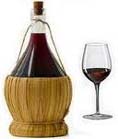Plates - 2
from Italian Traditional Food
Understanding plates
<< Previous Page 2 Next
>>
Continuation of the potted history of plates...
Josiah Wedgwood
But perhaps the most famous single name associated with the development of British pottery
including plates, is that of Josiah Wedgwood who, after being apprenticed to Thomas
Whieldon, first set up his own factory in 1759.
His own familiar invention is probably the typical, matt-surfaced jasperware, bearing copies of
classical garlands and frescoes in a white relief. Developed in the 1770s and enjoying then as much popularity as
it does today, it was made even at the outset for a collector's market. Josiah was proudest of his plaques and
vases but, nowadays, collectors go for the trinket boxes, jugs and bowls, made for display rather than use.
Early pieces bear the maker's name with that of Bentley, his partner and fellow-enthusiast for
the classical scene. If you find a bowl with "England" printed after the "Wedgwood", you will know that it was made
after 1891, when the American customs regulations declared that imported wares must be stamped with their country
of origin.
But Wedgwood also perfected creamware, a fine-quality Staffordshire stoneware that equalled
porcelain in appearance, but with the advantages of being stronger and much cheaper. It was from his supply of
creamware to Queen Charlotte that Wedgwood was entitled "Potter to the Queen".
Worcester pioneered another great English tradition. The factory was started in 1751 under Dr.
John Wall, and much of its best plates work was produced during his time. From 1751 until
1768, it made soft-paste porcelain with oriental decoration, following dictates of fashion. Halfway through this
period, transfer printing was developed and Worcester was quick to take advantage of the new technique. At first,
the transfers were printed over the glaze; later they appeared beneath the glaze. The principal colour used, of
course, was black, but you may also find examples of designs in brown and lavender.
Worcester was also influenced in its best designs by the fine French porcelain of Sevres and its
noted, even today, for its perfectly painted birds, fruit and flowers. The factory also produced quantities of
"blue and white" porcelain in imitation of the Chinese wares so popular at the time. The firm was first designated
"Royal Worcester" in 1788.
Look for the moulded "cabbage leaf" jugs and sauce boats so typically Worcester. Early ones are
naturally rarer than the chunky Victorian examples finding favour again today.
Page 3 of this Italian Traditional Food
article on plates can be found on the next page.
<< Previous
Page 2 Next >>

Copyright © 2009 -
. All Rights Reserved Worldwide. Italian Traditional Food
You may not reprint articles from this website
without the written permission of the site owner.
Disclaimer: Articles on this
Website are provided for information purposes only. Italiantraditionalfood.com does not accept any responsibility
or liability for the use or misuse of the article content on this site or reliance by any person on the site's
contents.
| 


 Digg
Digg Stumbleupon
Stumbleupon Google Bookmarks
Google Bookmarks Delicious
Delicious Twitter
Twitter Facebook
Facebook Yahoo My Web
Yahoo My Web Reddit
Reddit